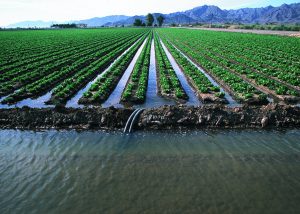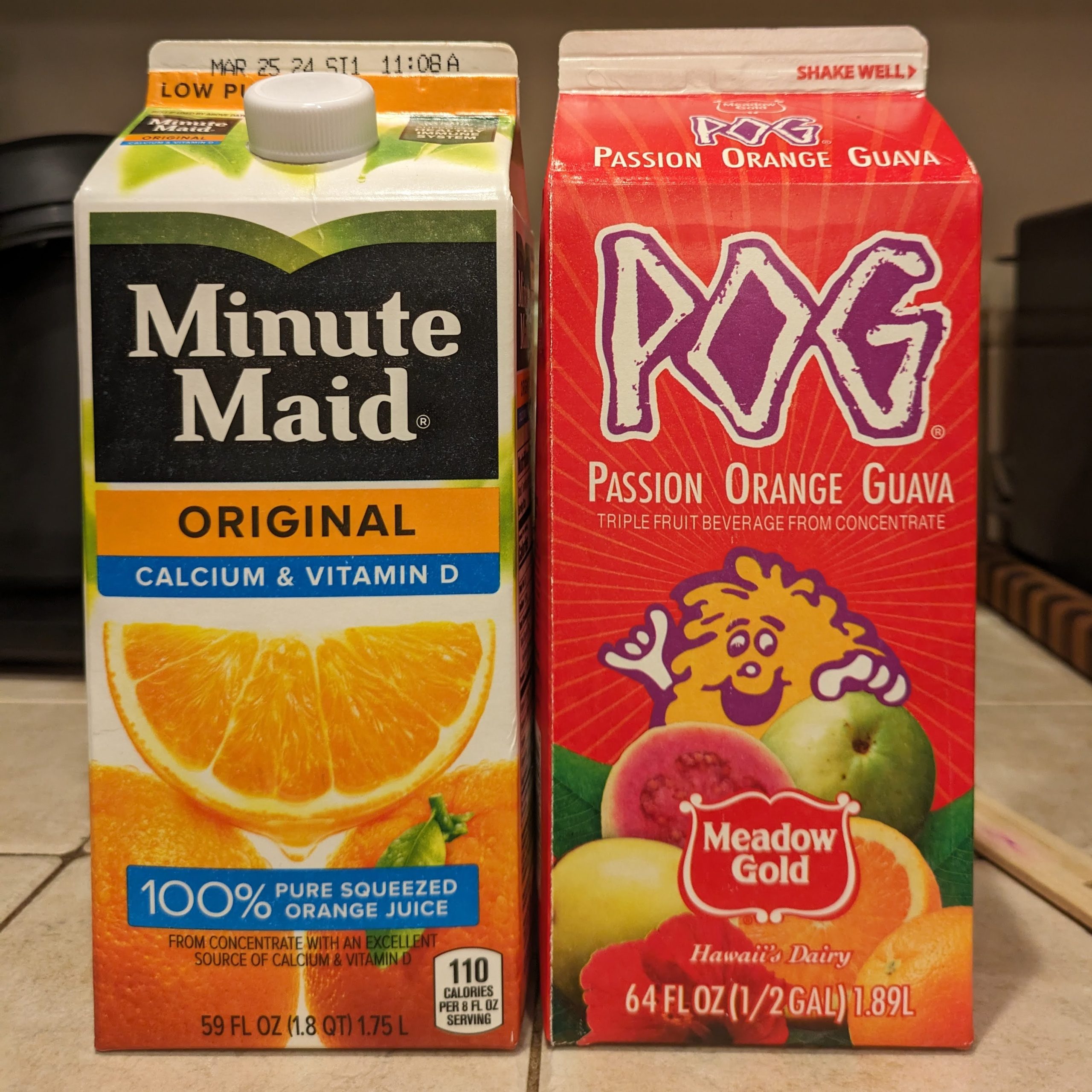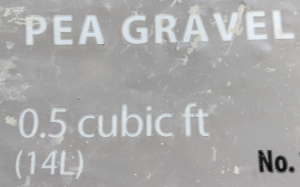1.5 Converting Volume
Applications
When we are dealing in units of measurement for water, the units we use typically depend on the scale of the project. For example, irrigation projects often use acre-feet, volume in rivers is usually expressed in cubic feet (and the volume over time in cubic feet per second), water treatment facilities work in million gallons, and water in pumps and home faucets is generally expressed in gallons.

Just as we saw with area, converting between units of volume requires us to be careful because cubic units behave differently than linear units.
Quantities of mulch, dirt, or gravel are often measured by the cubic yard. How many cubic feet are in one cubic yard?
[latex]1[/latex] yard = [latex]3[/latex] feet, so we can divide the length into three sections, the width into three sections, and the height into three sections to convert all three dimensions of the cube from yards to feet. This forms a [latex]3[/latex] by [latex]3[/latex] by [latex]3[/latex] cube, which shows us that [latex]1[/latex] cubic yard equals [latex]27[/latex] cubic feet. The linear conversion ratio of [latex]1[/latex] to [latex]3[/latex] means that that the conversion ratio for the volumes is [latex]1[/latex] to [latex]3^3[/latex], or [latex]1[/latex] to [latex]27[/latex].
Here's another way to think about it without a diagram: [latex]1\text{ yd}=3\text{ ft}[/latex], so [latex](1\text{ yd})^3=(3\text{ ft})^3[/latex]. To remove the parentheses, we must cube the number and cube the units: [latex](3\text{ ft})^3=3^3\text{ ft}^3=27\text{ ft}^3[/latex].
More generally, we need to cube the linear conversion factors when converting units of volume. If the linear units have a ratio of [latex]1[/latex] to [latex]n[/latex], the cubic units will have a ratio of [latex]1[/latex] to [latex]n^3[/latex].
Examples: One-Step Volume Conversions
A) 1 ft3 to in3 B) 1 in3 to cm3 C) 1 yd3 to ft3
D) 1 acre-foot to ft3
We can convert between units of volume and liquid capacity. As you might expect, the numbers are messy in the U.S. system.
[latex]1\text{ fl oz}\approx1.8047\text{ in}^3[/latex]
[latex]1\text{ ft}^3\approx7.4805\text{ gal}[/latex]
It's no surprise that the metric conversion ratios for volume are all powers of [latex]10[/latex]... but they are actually powers of [latex]1,000[/latex], or [latex]10^3[/latex], because the linear conversions get cubed when we go three-dimensional.
Converting volumes between the U.S. and metric systems will of course involve messy decimal values. For example, because [latex]1\text{ in}=2.54\text{ cm}[/latex], we can cube both numbers and find that [latex]1\text{ in}^3=(2.54\text{ cm})^3=[/latex] [latex]16.387064\text{ cm}^3[/latex].
Examples: Multiple-Step Volume Conversions
A) 1 ft3 to cm3 B) 15,000 in3 to m3 C) 1 acre-foot to yd3 D) 4.5 yd3 to in3
Examples: Applied Volume Conversions
A) A small reservoir holds 5 acre-feet of water. How many gallons of water is this?
B) A vial of fluorescent dye for marking salamanders contains 6 ounces of dye. If each salamander requires 0.5 cc (cm3), how many salamanders can we mark with this vial?
C) I built a chain-link dog run 32 ft x 10 ft. If I want to fill it with one-foot of bark to avoid mud, how many cubic yards of bark should I order?
Practice Exercises
- True story: A friend at the National Guard base gave us three long wooden crates to use as raised planting beds. (The crates probably carried some kind of weapons or ammunition, but our friend wouldn’t say.) Henry, who was taking geometry in high school, was asked to measure the crates and figure out how much soil we needed. The inside dimensions of each crate were [latex]112[/latex] inches long, [latex]14[/latex] inches wide, and [latex]14[/latex] inches deep. We wanted to fill them most of the way full with soil, leaving about [latex]4[/latex] inches empty at the top. How many cubic yards of soil did we need to order from the supplier?
- True story, continued: We decided to check our answer and did a rough estimate by rounding each dimension to the nearest foot, then figuring out the volume from there. Did this give the same result?
- A circular wading pool has a diameter of roughly 5 feet and a depth of 6 inches. How many gallons of water are required to fill it about [latex]80\%[/latex] of the way full?
- A standard U.S. soda pop can has a diameter of [latex]2\frac{1}{2}[/latex] inches and a height of [latex]4\frac{3}{4}[/latex] inches. Verify that the can is able to hold [latex]12[/latex] fluid ounces of liquid.
- A water jug that is roughly cube-shaped is advertised with dimensions [latex]10.51[/latex] inches deep, [latex]10.51[/latex] inches wide, and [latex]10.51[/latex] inches high. How many gallons is its capacity?
- The circular soaking tubs at Hot Lake Springs in La Grande, Oregon have an inner diameter of [latex]2.00[/latex] meters, and the water has a depth of [latex]0.75[/latex] meters. What is the approximate volume of water, in liters, in one of the tubs?
- A large dumpster in Iceland has a volume of [latex]15[/latex] cubic meters. Convert this to cubic yards.
- Suppose you need to know the volume of an Icelandic dumpster in cubic feet. Convert [latex]15\text{ m}^3[/latex] to [latex]\text{ ft}^3[/latex].

 A [latex]1.5\text{ L}[/latex] carton of orange juice has a square base [latex]9.5[/latex] centimeters on each side, and the height of the rectangular section is [latex]19[/latex] centimeters. (Ignore the triangular section at the top.) Verify that the carton holds [latex]1.5[/latex] liters of juice.
A [latex]1.5\text{ L}[/latex] carton of orange juice has a square base [latex]9.5[/latex] centimeters on each side, and the height of the rectangular section is [latex]19[/latex] centimeters. (Ignore the triangular section at the top.) Verify that the carton holds [latex]1.5[/latex] liters of juice.- A [latex]1.89\text{ L}[/latex] carton of POG juice has a square base [latex]9.5[/latex] centimeters on each side, and the height of the rectangular section is [latex]19.5[/latex] centimeters. This is not enough volume to hold [latex]1.89[/latex] liters of juice unless the sides of the carton bulge out. If you unfold the triangular top section to make a rectangular column and squeeze the sides of the carton so they aren't bulging out, what height will the juice rise to?
- A "two yard" dumpster at a campground in Washington has a volume of [latex]2[/latex] cubic yards. Convert this to cubic meters.

What rubbish! - The engine of a 1964 Corvette has 8 cylinders with a bore (diameter) of [latex]4.00[/latex] inches and a stroke (height) of [latex]3.25[/latex] inches. Find the total displacement (volume) of the cylinders in this engine, rounded to the nearest cubic inch.[1] Convert the displacement of the Corvette engine into liters.

Photo by Chevrolet via Wikimedia Commons 13. A hardware store sells pea gravel in [latex]0.5\text{ ft}^3[/latex] bags. The bags are also marked [latex]14\text{ L}[/latex]. Verify that these two measures are equivalent.

Problem Set 1.5
- Convert 780 cubic feet to gallons.
- Convert 1,200 gallons to cubic feet.
- Convert 1 cubic foot to cubic inches.
- Convert 1 cubic foot to cubic centimeters (cc = [latex]cm^3[/latex]). Note: 1 cc = 1 ml
- Convert 2,400 cubic inches to cubic feet.
- Convert 28,456 [latex]cm^3[/latex] to gallons.
- Convert 1 acre-foot to cubic feet.
- Convert 1 acre-foot to gallons.
- How many gallons are in 3 cubic yards?
- The average U.S. household consumes 400 gallons of water per day. How many cubic feet of water is this? How many acre-feet of water would the average household use in a week?
- The formula is often written as [latex]V=\frac{\pi}{4}\cdot{b^2}\cdot{s}\cdot{c}[/latex], where [latex]c[/latex] is the number of cylinders. ↵
The amount of water that will cover a one-acre field to a depth of one foot. This hearkens back to flood irrigation practices, where water is released from a ditch to flood the surface of an agricultural field. The volume of water in reservoirs is often expressed in acre feet. One acre foot is equivalent to 43,560 cubic feet because one acre is 43,560 square feet.
The rate of water movement representing a volume of one cubic foot passing a given point during one second. Abbreviated cfs or ft3/sec

